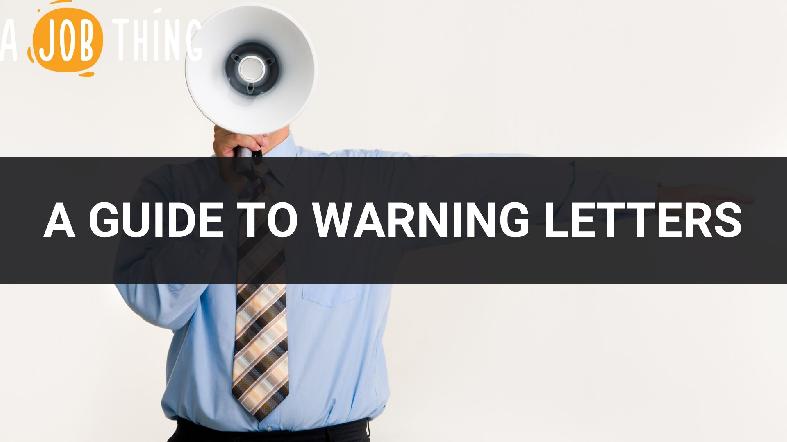
How to Write Professional Warning Letter to Employee (With Templates and Sample)
Create Job Description Using AI
Write appealing job descriptions for any job opening to attract the most qualifield and suitable candidates. FOR FREE.
try now
When an employee starts performing poorly or engaging in minor misconduct, it's important to take disciplinary action. Warning letters can be useful in such situations. They can be used for various issues, including poor performance, absence, misconduct, and coming late. Warning letters serve as a formal record of the problem and its consequences. You can find sample letters and templates to help you create one. By following proper procedures and using the right documentation, like warning letters and verbal warnings, employers can address the issues, set expectations, and maintain a productive work environment.
However, in the case of a one-time severe offence, it may be advisable to forgo the verbal warning and proceed directly to issuing a warning letter. Doing so establishes a documented record that can be kept in the employee's file, providing evidence of the incident and ensuring clarity about the consequences.
What is a Warning Letter to Employee?
- A warning letter to an employee is a formal written communication from an employer to address specific concerns or issues regarding the employee's behaviour or performance.
- It serves as a documented record, emphasizing the consequences of their actions.
- Warning letters are commonly used for various situations, including poor performance, absenteeism, misconduct, and late coming.
- A warning letter aims to communicate the problems to the employee and urge them to improve.
- It outlines the specific incidents or areas of concern, providing a timeline for improvement.
- Sample warning letters or templates can serve as helpful references when creating one.
- The warning letter addresses the issues, encourages better performance, and maintains a positive work environment.
- It is an important step in the disciplinary process, highlighting the need for improvement and potential further consequences if the problems persist.
- Sometimes, a verbal warning may precede the written warning letter to ensure clear communication.
Read more about: When is the Right Time to Fire an Under-performing Employee
Gathering Relevant Information and Documentation
When preparing a professional warning letter to an employee, gathering all the necessary information and documentation to support your case is crucial. This step helps ensure the letter accurately reflects the employee's conduct or performance issues.
Here are some key points to consider:
- Review records: Take the time to review the employee's performance records, attendance records, or any previous disciplinary actions. This will comprehensively understand the employee's history and help you identify patterns or recurring issues.
- Collect evidence: Collect any tangible evidence or documentation that supports your claims. This may include performance evaluations, attendance records, customer complaints, or other relevant documents. Ensure confidentiality and adhere to legal requirements when handling sensitive information.
- Interview witnesses: If applicable, speak to colleagues, supervisors, or clients who may have witnessed or been affected by the employee's behaviour or performance. Gathering statements or testimonies can provide additional credibility to your case.
- Be objective: Maintain objectivity throughout the gathering process. Focus on factual information and avoid personal biases or opinions. This will ensure that the warning letter remains fair, professional, and unbiased.
By thoroughly gathering relevant information and documentation, you will have a solid foundation for writing a professional and well-supported warning letter to the employee.
Things to Do Before Writing a Warning Letter to Employee
- Speak to the employee privately: Ensure the conversation about the misconduct is held privately, maintaining confidentiality and professionalism.
- Deliver the warning note promptly: Issue the warning letter as soon as the incident occurs to address the matter promptly and demonstrate the seriousness of the situation.
- Reinforce consequences in the draft: Reiterate the consequences of the employee's misconduct in the formal warning letter, emphasizing the potential impact on their employment.
- Ask for the employee's signature: While not mandatory, obtaining the employee's signature on the warning letter confirms their acknowledgement of the issue and the expected improvements.
- Keep it objective and factual: Maintain a neutral and unbiased tone in the warning letter, focusing on facts and specific incidents rather than personal opinions or emotions.
- Proofread the letter: Have an HR colleague or another trusted individual review the warning letter for accuracy, clarity, and adherence to company policies and procedures.
- Consider seeking legal advice: If you need clarification on the legal implications of the disciplinary action, consult with a lawyer or HR expert to ensure compliance with relevant laws and regulations.
Structure of a Warning Letter: Key Elements
When composing a warning letter to an employee, it's important to follow a structured format to ensure clarity and professionalism.
Here are the key elements to include in the letter:
- Date and Employee Information: Begin the letter by including the current date and the employee's full name, job title, and employee identification number, if applicable. This helps in identifying the recipient and establishing a formal tone.
- Introduction and Purpose: Clearly state the letter's purpose in the introduction. A warning letter addresses employee conduct, performance, or behaviour concerns.
- Description of the Issue: Provide a detailed description of the problem, clearly outlining the specific incident(s), behaviour (s), or performance-related concerns. Use objective language and refer to any relevant policies or expectations the employee violated.
- Supporting Evidence: Present factual evidence or documentation that supports your claims. This may include performance evaluations, attendance records, incident reports, or other relevant evidence. Be sure to maintain confidentiality and comply with legal requirements.
- Impact and Consequences: Describe how the employee's actions have negatively affected the workplace, team, or company. Clearly explain the potential consequences if the issue persists, such as further disciplinary actions or termination.
- Expectations and Improvement Plan: Communicate the expectations for improvement and specify the desired changes in behaviour or performance. Guide how the employee can rectify the issue and offer support if applicable. Set a reasonable timeline for improvement and suggest any necessary steps or resources.
- Next Steps and Signature: Clearly state what the employee should expect after receiving the warning letter. Sign off with a professional closing, including your name, job title, and contact information.
By following this structured approach, you can ensure that your warning letter is organized, concise, and effective in addressing the employee's performance or conduct issues.
FAQs:
1. Can the HOD Issue a warning letter before HR?
2. How to write a warning letter?
3. What is the difference between verbal and written warnings?
4. How to address an employee who takes extensive lunch breaks?
5. How to prevent an employee from suing during termination?
Employee Warning Letter Sample and Template
Warning Letter Template 1
Download Here
.png)
Warning Letter Template 2
Download Here
.png)
National Human Resource Centre (NHRC) Warning Letter Template
Download Here
.png)
Warning Letter for Poor Performance
Download Here
.png)
Warning Letter after Disciplinary Inquiry
Download Here
Download all the templates here
Source: CareerAddict
Related articles
HR Guide: Job Promotion Letters and Templates
Interview Invitation Guide with 7 Free Templates
7 Candidate Rejection Email Templates For HR

.png)




